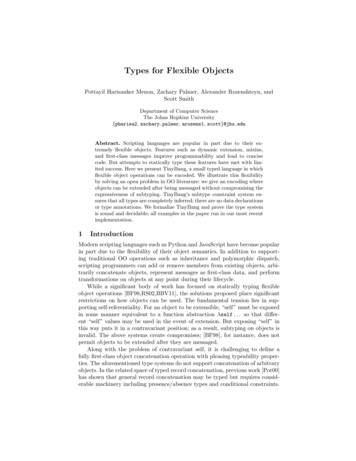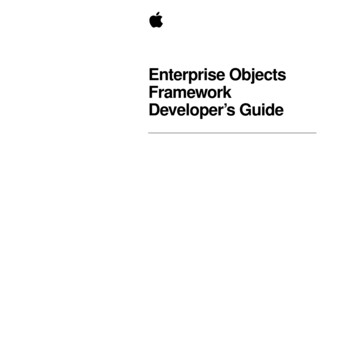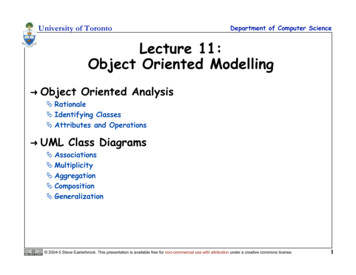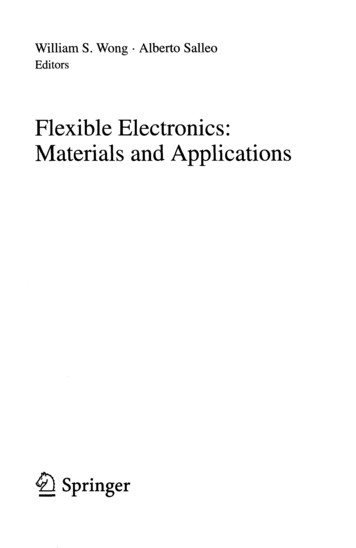
Transcription
Types for Flexible ObjectsPottayil Harisanker Menon, Zachary Palmer, Alexander Rozenshteyn, andScott SmithDepartment of Computer ScienceThe Johns Hopkins University{pharisa2, zachary.palmer, arozens1, scott}@jhu.eduAbstract. Scripting languages are popular in part due to their extremely flexible objects. Features such as dynamic extension, mixins,and first-class messages improve programmability and lead to concisecode. But attempts to statically type these features have met with limited success. Here we present TinyBang, a small typed language in whichflexible object operations can be encoded. We illustrate this flexibilityby solving an open problem in OO literature: we give an encoding whereobjects can be extended after being messaged without compromising theexpressiveness of subtyping. TinyBang’s subtype constraint system ensures that all types are completely inferred; there are no data declarationsor type annotations. We formalize TinyBang and prove the type systemis sound and decidable; all examples in the paper run in our most recentimplementation.1IntroductionModern scripting languages such as Python and JavaScript have become popularin part due to the flexibility of their object semantics. In addition to supporting traditional OO operations such as inheritance and polymorphic dispatch,scripting programmers can add or remove members from existing objects, arbitrarily concatenate objects, represent messages as first-class data, and performtransformations on objects at any point during their lifecycle.While a significant body of work has focused on statically typing flexibleobject operations [BF98,RS02,BBV11], the solutions proposed place significantrestrictions on how objects can be used. The fundamental tension lies in supporting self-referentiality. For an object to be extensible, “self” must be exposedin some manner equivalent to a function abstraction λself . . . so that different “self” values may be used in the event of extension. But exposing “self” inthis way puts it in a contravariant position; as a result, subtyping on objects isinvalid. The above systems create compromises; [BF98], for instance, does notpermit objects to be extended after they are messaged.Along with the problem of contravariant self, it is challenging to define afully first-class object concatenation operation with pleasing typeability properties. The aforementioned type systems do not support concatenation of arbitraryobjects. In the related space of typed record concatenation, previous work [Pot00]has shown that general record concatenation may be typed but requires considerable machinery including presence/absence types and conditional constraints.
In this paper, we present a new programming language calculus, TinyBang,which aims for significant flexibility in statically typing flexible object operations.In particular, we support object extension without restrictions, and we havesimple type rules for a first-class concatenation operation.TinyBang achieves its expressiveness with very few primitives: the core expressions include only labeled data, concatenation, higher-order functions, andpattern matching. Classes, objects, inheritance, object extension, overloading,and switch/case can be fully and faithfully encoded with these primitives. TinyBang also has full type inference for ease and brevity of programming. It is notintended to be a programming language for humans; instead, it aims to serve asa conceptual core for such a language.1.1Key Features of TinyBangTinyBang’s type system is grounded in subtype constraint type theory [AWL94],with a series of improvements to both expression syntax and typing to achievethe expressiveness needed for flexible object encodings.Type-indexed records supporting asymmetric concatenation TinyBang usestype-indexed records: records for which content can be projected basedon its type [SM01]. For example, consider the type-indexed record{foo 45; bar 22; 13}: the untagged element 13 is implicitly tagged withtype int, and projecting int from this record would yield 13. Since recordsare type-indexed, we do not need to distinguish records from non-records; 22,for example, is a type-indexed record of one (integer) field. Variants are alsojust a special case of 1-ary records of labeled data, so ‘Some 3 expresses theML Some(3). Type-indexed records are thus a universal data type and lendthemselves to flexible programming patterns in the same spirit as Lisp lists andSmalltalk objects.TinyBang records support asymmetric concatenation via the & operator; informally, {foo 45; bar 22; 13} & {baz 45; bar 10; 99} resultsin {foo 45; bar 22; baz 45; 13} since the left side is given priority for theoverlap. Asymmetric concatenation is key for supporting flexible object concatenation, as well as for standard notions of inheritance. We term the & operationonioning.Dependently typed first-class cases TinyBang’s first-class functions are written“pattern - expression”. In this way, first-class functions are also first-class caseclauses. We permit the concatenation of these clauses via & to give multipledispatch possibilities. TinyBang’s first-class functions generalize the first-classcases of [BAC06].Additionally, we define a novel notion of union elimination, a slice, whichallows the type of bindings in a case arm to be refined based on which patternwas matched. Dependently typed first-class cases are critical for typing our objectencodings, a topic we discuss in the next section.Outline In the next section, we give an overview of TinyBang and how it canencode object features. In Section 3, we show the operational semantics and type
system for a core subset of TinyBang, trimmed to the key features for readability;we prove soundness and decidability for this system in the appendices. Relatedwork is in Section 4 and we conclude in Section 5.2OverviewThis section gives an overview of the TinyBang language and of how it supportsflexible object operations and other scripting features.2.1 Language Features for Flexible ObjectsThe TinyBang expression syntax used in this section appears in Figure 2.1.eφl:: :: :: :: x () Z l e ref e ! e e & e φ - e e e e e let x e in e x : e in ex () int l φ φ & φpatterns - operators‘(alphanumeric)labelsFig. 2.1. TinyBang SyntaxProgram types take the form of a set of subtype constraints [AWL94]. For thepurposes of this Overview we will be informal about type syntax. For example,the informal int bool is in fact be expressed via constraints int : α and bool : α. The details of the type system are presented in Section 3.3.Simple functions as methods We begin by considering the oversimplified case ofan object with a single method and no fields or self-awareness. In the variantencoding, such an object is represented by a function which pattern-matcheson the message identifying that single method. We see in Figure 2.1 that allTinyBang functions are written φ - e, with φ being a pattern to match againstthe function’s argument. Each function has only one pattern; we call these oneclause pattern-matching functions simple functions. For instance, consider thefollowing object and its invocation:1let obj (‘twice x - x x) in obj (‘twice 4)The syntax ‘twice 4 is a label constructor similar to an OCaml polymorphicvariant or Haskell newtype; like these languages, the expression ‘twice 4 hastype ‘twice int. The simple function ‘twice x - x x is a function whichmatches on any argument containing a ‘twice label and binds its contents tothe variable x. Note that the expression ‘twice 4 is a first-class message.A simple function is only capable of matching one pattern; to express generalpattern matching, functions are concatenated via the onion operation & to givecompound functions. Given two function expressions e1 and e2, the expression(e1 & e2) conjoins them to make a compound function. (e1 & e2) arg will applythe function which has a pattern matching arg; if both patterns match arg, theleftmost function (e.g. e1) is given priority. For example:1let obj (‘twice x - x x) & (‘isZero x - x 0) in obj ‘twice 4The above shows that traditional match expressions can be encoded using the& operator to join a number of simple functions: one for each case. Because these
functions are values, TinyBang’s function conjunction generalizes the first-classcases of [BAC06]; that work does not support “override” of existing clauses orheterogeneously typed case branches.Dependent pattern types The above shows the encoding of a simple object withtwo methods, no fields, and no self-awareness, but this function conjunction approach presents some typing challenges. Consider the analogous OCaml match/case expression:12let obj m (match m with ‘twice x - x x ‘isZero x - x 0) in . . .This will not typecheck, since the same type must be returned for all branches.1We resolve this in TinyBang by giving the function a dependent pattern type(‘twice int int) & (‘isZero int bool). If the function is applied in thecontext where the type of message is known, the appropriate result type is inferred; for instance, invoking this method with ‘isZero 0 always produces typebool and not type int bool. When we present the formal type system below, we show how these dependent pattern types extend the expressiveness ofconditional constraint types [AWL94,Pot00] in a dimension critical for typingobjects.This need for dependent typing arises largely from our desire to accuratelytype a variant-based object model; a record-based encoding of objects would nothave this problem. We choose a variant-based encoding because it greatly simplifies encodings such as self-passing and overloading, which we describe below.Onions are records There is no record syntax in TinyBang; instead, it suffices touse concatenation (&) on labeled values. We informally call these records onionsto signify these properties. Here is an example of how multi-argument methodscan be defined:123let obj (‘sum (‘x x & ‘y y) - x y)& (‘equal (‘x x & ‘y y) - x y)in obj (‘sum (‘x 3 & ‘y 2))The ‘x 3 & ‘y 2 amounts to a two-label record. This ‘sum-labeled onion ispassed to the pattern ‘x x & ‘y y. (We highlight the pattern & differently thanthe onioning & because the former is a pattern conjunction operator: the valuemust match both subpatterns.) Also observe from this example how there is nohard distinction in TinyBang between records and variants: there is only oneclass of label. This means that the 1-ary record ‘sum 4 is the same as the 1-aryvariant ‘sum 4.2.2 Self-Awareness and Resealable ObjectsUp to this point, objects have no self-awareness: they cannot invoke their ownmethods. Encoding a runtime model of self-awareness is simple; for instance,dynamic dispatch can be accomplished simply by transforming each method1The recent OCaml 4 GADT extension mitigates this difficulty but requires an explicittype declaration, type annotations, and only works under a closed world assumption.
invocation (e.g. obj.m(arg)) into a function call in which the object is passed toitself (e.g. obj (‘self obj & ‘m arg)). But while this model exhibits appropriateruntime behavior, it does not typecheck properly in the presence of subtyping.Consider the code in Figure 2.2 and the Java statement A obj new B();. Theencoding of obj.foo() here would fail to typecheck; the B implementation of fooexpects this to have a bar method, but the weakened obj cannot guarantee this.Although this example uses Java type annotations to weaken the variable’s type,similar weakening eventually occurs with any decidable type inference algorithm.We also observe that the same problem arises if, rather than self-passing at thecall site, we encode the object to carry itself in a field.class B extends A {int foo() { return this.bar(); }int bar() { return 8; }}Fig. 2.2. Self-Encoding Example Codeclass A {int foo() { return 4; }}The simple approach shown above fails because, informally, the object doesnot know its own type. To successfully typecheck dynamic dispatch, we mustkeep an internal type for the object separate from the external type it has inany particular context; that is, in the above example, the object must rememberthat it is a B-typed object even when it is generalized e.g. in an A-typed variable.One simple approach to this is to capture an appropriate self-type in closure,similar to how functions can recurse via self-passing:123let obj0 self - (‘foo & ‘self self - self self (‘bar & ‘self self)) &(‘bar & ‘self self - 8) inlet obj obj0 obj0 in . . .The initial passing of obj0 to itself bootstraps the self-passing mechanism; objbecomes a function with obj0 captured in closure as self; thus, any messagepassed to obj uses the type of obj0 at the time obj was created rather thanrelying on its type in context. While this approach is successful in creating a selfaware object, it interferes with extensibility: the type of self is fixed, preventingadditional methods from being added or overridden.To create an extensible encoding of dynamically dispatched objects, we buildon the work of [BF98]. In that work, an object exists in one of two states:as a prototype, which can be extended but not messaged, or as a “proper”object, which can be messaged but not extended. Prototypes cannot be messagedbecause they do not yet have a notion of their own type. A prototype may be“sealed” to transform it into a proper object, capturing the object’s type ina fashion similar to the above. A sealed object may not be extended for thesame reason as the above: there exists no mechanism to modify or specialize thecaptured self-type.The work we present here extends [BF98] with two notable refinements. First,that work presents a calculus in which objects are primitives; in TinyBang, however, objects and the sealing process itself are encoded using simple functionsand conjunction. Second, TinyBang admits a limited context in which sealed
objects may be extended and then resealed, thus relaxing the sharp phase distinction between prototypes and proper objects. All object extension below willbe performed on sealed objects. Object sealing is accomplished by a TinyBangfunction seal:1234567let fixpoint f - (w - w w) (t - a - f (t t) a) inlet seal fixpoint (seal - obj - (msg - obj (msg & ‘self (seal obj))) & obj) inlet obj (‘twice x - x x) &(‘quad x & ‘self self - self (‘twice x) self (‘twice x))let sObj seal obj inlet twenty sObj ‘quad 5 in// returns 20Here, fixpoint is simply the Y-combinator. The seal function operates by addinga message handler which captures every message sent to obj. (We still add & objto this message handler to preserve the non-function parts of the object.) Thismessage handler captures the type of obj in the closure of a function; thus, laterinvocations of this message handler will continue to use the type at seal-timeeven if the types of variables containing the object are weakened. The messagehandler adds a ‘self component containing the sealed object to the right of themessage and then passes it to the original object. We require fixpoint to ensurethat this self-reference is also sealed. So, every message sent to sObj will be senton to obj with ‘self sObj added to the right. Note that the ‘twice methoddoes not require a ‘self pattern component: due to structural subtyping, anymessage with a ‘twice label (whether it also includes a ‘self or not) will do.The key to preserving extensibility with this approach is the fact that, whilethe seal function has captured the type of obj in closure, the self value isstill sent to the original object as an argument. We now show how this permitsextension of sealed objects in certain contexts.Extending previously sealed objects In the definition of seal above, the catch-allmessage handler adds a ‘self label to the right of the message; thus, if any‘self label already existed in the message, it would be given priority over theone added by seal. We can take advantage of this behavior in order to extenda sealed object and then reseal it, refining its self-type. Consider the followingcontinuation of the previous code:1234letletletletsixteen sObj ‘quad 4 in// returns 16obj2 (‘twice x - x) & sObj insObj2 seal obj2 ineight sObj2 ‘quad 4 in . . .// returns 8We can extend sObj after messaging it, here overriding the ‘twice message;sObj2 represents the (re-)sealed version of this new object. sObj2 properly knowsits “new” self due to the resealing, evidenced here by how ‘quad invokes the new‘twice. To see why this works let us trace the execution. Expanding the sealingof sObj2, sObj2 (‘quad 4) has the same effect as obj2 (‘quad 4 & ‘self sObj2),which has the same effect as sObj (‘quad 4 & ‘self sObj2). Recall sObj is also asealed object which adds a ‘self component to the right; thus this has the same
effect as obj (‘quad 4 & ‘self sObj2 & ‘self sObj). Because the leftmost ‘selfhas priority, the ‘self is properly sObj2 here. We see from the original definitionof obj that it sends a ‘twice message to the contents of self, which then followsthe same pattern as above until obj (‘twice 4 & ‘self sObj2 & ‘self sObj) isinvoked (two times – once for each side of ).Sealed and resealed objects obey the desired object subtyping laws becausewe “tie the knot” on self using seal, meaning there is no contravariant self parameter on object method calls to invalidate object subtyping. Additionally, ourtype system includes parametric polymorphism and so sObj and the re-sealedsObj2 do not have to share the same self type, and the fact that & is a functionalextension operation means that there will be no pollution between the two distinct self types. Key to the success of this encoding is the asymmetric natureof &: it allows us to override the default ‘self parameter. This self resealing ispossible in the record model of objects, but is much more convoluted; this is areason that we switched to a variant model.It should be noted that this resealing approach is limited to contexts inwhich no type information has yet been lost regarding the sealed object. Usingthe example from Figure 2.2, typechecking would likely fail if one were to seal aB, weaken its type to an A, extend it, and then reseal the result: the new selftype would be derived from A, not B, and so would still lack knowledge of thebar method. The runtime behavior is always correct, and typechecking wouldalso succeed if the extension provided its own override of the bar method for thenewly-sealed object to use.Onioning it all together Onions also provide a natural mechanism for includingfields; we simply concatenate them to the functions that represent the methods.Consider the following object which stores and increments a counter:123let obj seal (‘x (ref 0) &(‘inc & ‘self self - (‘x x - x : !x 1 in !x) self))in obj ‘inc ()Observe how obj is a heterogeneous “mash” of a record field (the ‘x) and afunction (the handler for ‘inc). This is sound because onions are type-indexed[SM01], meaning that they use the types of the values themselves to identifydata. For this particular example, invocation obj ‘inc () (note () is an emptyonion, a 0-ary conjunction) correctly increments in spite of the presence of the‘x label in obj.The above counter object code is quite concise: it defines a self-referential,mutable counter object using no syntactic sugar whatsoever in a core languagewith no explicit object syntax. But as we said before, we do not expect programmers to write directly in TinyBang under normal circumstances. Here area few syntactic sugarings used in subsequent examples. (A “real” language builton these ideas would include sugarings for each of the features we are about tomention as well.)
o.xo.x e1 in e2if e1 then e2 else e3e1 and e22.3 (‘x x - x) o (‘x x - x e1 in e2 ) o ((‘True - e2 ) & (‘False - e3 )) e1 ((‘True - e2 ) & (‘False - ‘False ())) e1Flexible Object OperationsWe now cover how TinyBang supports a wealth of flexible object operations,expanding on the first-class messages and flexible extension operations coveredabove. We show encodings in terms of objects rather than classes for simplicity;applying these concepts to classes is straightforward.Default arguments TinyBang can easily encode optional arguments that take ona default value if missing. For instance, consider:12345let obj seal ( (‘add (‘x x & ‘y y) - x y)& (‘sub (‘x x & ‘y y) - x - y) ) inlet dflt obj - (‘add a - obj (‘add (a & ‘x 1))) & obj inlet obj2 dflt obj inobj2 (‘add (‘y 3)) obj2 (‘add (‘x 7 & ‘y 2)) // 4 9Object dflt overrides obj’s ‘add to make 1 the default value for ‘x. Becausethe ‘x 1 is onioned onto the right of a, it will have no effect if an ‘x is explicitlyprovided in the message.Overloading The pattern-matching semantics of functions also provide a simplemechanism whereby multi-functions can be defined to overload their behavior.We might originally define negation on the integers as1let neg x & int - 0 - x in . . .Here, the conjunction pattern x & int will match the argument with int andalso bind it to the variable x. Later code could then extend the definition ofnegation to include boolean values. Because multi-functions assign new meaningto an existing symbol, we redefine neg to include all of the behavior of the oldneg as well as new cases for ‘True and ‘False:1let neg (‘True - ‘False ()) & (‘False - ‘True ()) & neg in . . .Negation is now overloaded: neg 4 evaluates to -4, and neg ‘True () evaluatesto ‘False () due to how application matches function patterns.Mixins The following example shows how a simple two-dimensional point objectcan be combined with a mixin providing extra methods:12345let point seal (‘x (ref 0) & ‘y (ref 0)& (‘l1 & ‘self self - self.x self.y)& (‘isZero & ‘self self - self.x 0 and self.y 0)) inlet mixin ‘near & ‘self self - self ‘l1 ()) 4) inlet mixPt seal (point & mixin) in mixPt ‘near ()
Here mixin is a function which invokes the value passed as self. Because anobject’s methods are just functions onioned together, onioning mixin into pointis sufficient to produce a properly functioning mixPt.The above example typechecks in TinyBang; parametric polymorphism isused to allow point, mixin, and mixPt to have different self-types. The mixinvariable has the approximate type “(‘near unit & ‘self α) bool where α isan object capable of receiving the ‘l1 message and producing an int”. mixin canbe onioned with any object that satisfies these properties. If the object does nothave these properties, a type error will result when the ‘near message is passed;for instance, (seal mixin) (‘near ()) is not typeable because mixin, the valueof self, does not have a function which can handle the ‘l1 message.TinyBang mixins are first-class values; the actual mixing need not occur untilruntime. For instance, the following code selects a weighting metric to mix intoa point based on some runtime condition cond.123456let cond (runtime boolean) in let point (as above) inlet w1 (‘weight & ‘self self - self.x self.y) inlet w2 (‘weight & ‘self self - self.x - self.y) inlet mixPt seal (point & (if cond then w1 else w2)) inmixPt ‘weight ()Inheritance, classes, and subclasses Typical object-oriented constructs can bedefined similarly to the above. Object inheritance is similar to mixins, but avariable super is also bound to the original object and captured in the closure ofthe inheriting objects methods, allowing it to be reached for static dispatch. Theflexibility of the seal function permits us to ensure that the inheriting object isused for future dispatches even in calls to overridden methods. Classes are simplyobjects that generate other objects, and subclasses are extensions of those objectgenerating objects. We forgo examples here for brevity.3FormalizationHere we give formal semantics to TinyBang. For clarity, features which are notunique to our semantics – integers, state, etc. – are omitted. We first translateTinyBang programs to A-normal form; Section 3.2 defines the operational semantics of the A-normalized version of restricted TinyBang. Section 3.3 definesthe type system and soundness and decidability properties. The full technicalreport [MPRS14b] shows how the omitted features are handled.Notation For a given construct g, we let [g1 , . . . , gn ] denote an n-ary list of g,n often using the equivalent shorthand g . We elide the n when it is unnecessary.n Operator k denotes list concatenation. For sets, we use similar notation: g abbreviates {g1 , . . . , gn } for some arbitrary ordering of the set.3.1 A-TranslationIn order to simplify our formal presentation, we convert TinyBang into A-normalform; this brings expressions, patterns, and types into close syntactic alignment
which greatly simplifies the proofs. The grammar of our A-normalized languageappears in Figure 3.1. For the purposes of discussion, we will refer to the restriction of the language presented in Section 2 as the nested language and to thelanguage appearing in Figure 3.1 as the ANF language.esEvl :: sexpressions:: x v x x x x xclauses:: x venvironment:: Z () l x x & x φ - e values:: ‘(alphanumeric)labels φ :: x v̊patternsB :: x xv̊ :: int () l x x & xx :: (alphanumeric)bindingspattern valsvariablesFig. 3.1. TinyBang ANF GrammarObserve how expression and pattern grammars are nearly identical. We require that both expressions and patterns declare each variable at most once;expressions and patterns which do not have this property must be α-renamedsuch that they do. The constructions E and B are not directly used in theA-translation; they define the environment and bindings in the semantics.We define the A-translation function HeIx in Figure 3.2. Here, e is a nested TinyBang expression; the result is the A-normalized form s in which the finaldeclared variable is x. We overload this notation to patterns as well. We use yand z to range over fresh variables unique to that invocation of H I ; differentrecursive invocations use different fresh variables y and z.ExpressionsH()IxHl eIxHe1 & e2 IxHφ - eIxHe1 e2 IxHlet x1 e1 in e2 Ix2Hx2 Ix1 [x ()]HeIy k[x l y]He1 Iy k He2 Iz k[x y & z][x HφIy - HeIz ]He1 Iy k He2 Iz k[x y z]He1 Ix1 k He2 Ix2[x1 x2 ]PatternsH()IxHl φIxHφ1 & φ2 IxHx2 Ix1 [x ()]HφIy k[x l y]Hφ1 Iy k Hφ2 Iz k[x y & z][x2 ()]Fig. 3.2. TinyBang A-TranslationNotice that A-translation of patterns is in perfect parallel with the expressions in the above; for example, the expression ‘A x - x translates to[y1 ([x (), y3 ‘A x] - [y2 x])]. Using the same A-translation for patterns and expressions greatly aids the formal development, but it takes somepractice to read these A-translated patterns. Variables matched against emptyonion (x () here) are unconstrained and represent bindings that can be usedin the body. Variables matched against other pattern clauses (such as y3 ) are notbindings; clause y3 ‘A x constrains the argument to match a ‘A-labeled value.The last binding in the pattern, here y3 ‘A x, is taken to match the argumentwhen the function is applied; this is in analogy to how the variable in the lastclause of an expression is the final value. Variable binding takes place on ()(wildcard) definitions: every pattern clause x () binds x in the function body.In clause lists, each clause binds the defining variable for all clauses appearingafter it; nested function clauses follow the usual lexical scoping rules. For theremainder of the paper, we assume expressions are closed unless noted.
3.2 Operational SemanticsNext, we define an operational semantics for ANF TinyBang. The primary complexity of these semantics is pattern matching, for which several auxiliary definitions are needed.Compatibility The first basic relation we define is compatibility: is a valueaccepted by a given pattern? We define compatibility using a constructive failuremodel for reasons of well-foundedness which are discussed below. We use thesymbol to range over the two symbols and #, which indicate compatibilityand incompatibility, respectively, and order them: # . BWe write x E φ x0 to indicate that the value x is compatible (if )or incompatible (if #) with the pattern x0 . E represents the environmentin which to interpret the value x while φ represents the environment in whichto interpret the pattern x0 . B dictates how, upon a successful match, the valuesfrom E will be bound to the pattern variables in φ. Compatibility is the leastrelation satisfying the rules in Figure 3.3.Empty Onionx0 v Ex00 () φx0 E BφB [x00 x0 ]x0 l x 1 Ex00 1 B1 0E φ x1min( 1 , 2 ) B1 k B2x0E φx0x0 2 B2E φx0 E Bφx00 x01 & x02 /φB 0x0 E φ x0Label Mismatchx0 l x 1 Ex00 v̊ φx0 x1 & x2 Ex00Onion Value Rightx0 x1 & x2 Ex00Onion Value Leftx02# []x0 E φ0# Bx1 E φ x00v̊ l0 x2 only if l 6 l0B 0x1 E φ x1x00 l x01 φBx0 E φConjunction Patternx00 x01 & x02 φLabel0x 1 E Bφ x0x00B 0x2 E φ x0v̊ not of the form x0 & x00 or ()x00Fig. 3.3. Pattern compatibility rulesThe compatibility relation is key to TinyBang’s semantics and bears someexplanation. As mentioned above, every clause x () appearing in the patternbinds the variable x; the Empty Onion rule ensures this by adding a bindingclause to B. The Label rule simply recurses when the value is a label and thepattern matches that label; the Label Mismatch rule (which is the base casefor failure) applies when the pattern does not match that label. Conjunction isrelatively self-evident; min is used here as a logical “and” over the two recursivepremises. The onion rules reflect TinyBang’s asymmetric concatenation semantics. Given a value x1 & x2 , it is possible that both x1 and x2 match the pattern.If so, we must ensure that we take the bindings from the compatibili
1 The recent OCaml 4 GADT extension mitigates this di culty but requires an explicit type declaration, type annotations, and only works under a closed world assumption. invocation (e.g. obj.m(arg)) into a function call in which the object is passed to itself (e.g. obj ('selfobj&'m arg)). But while this model exhibits appropriate











